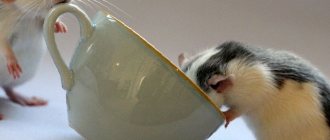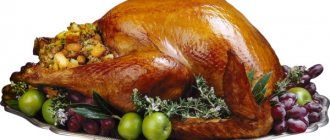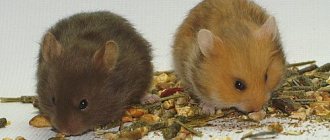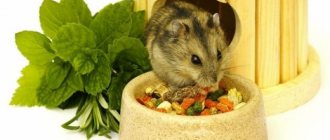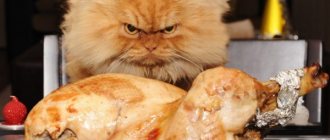Feeding rules and diet at home
Like all pets, rabbits require proper care.
It may seem that your pet rabbit is constantly hungry. In fact, due to their low protein content, vegetables are quickly digested. Therefore, starvation for long-eared pets is equivalent to death. An adult pet needs to eat 40-50 times a day in small portions.
Due to weak peristalsis (contraction of the intestinal muscles), the colon becomes clogged and there is not enough saliva for digestion.
Therefore, another mandatory component of the diet is clean water.
Feeds are divided into juicy, rough, green, and combined. For the proper development of a baby rabbit, the menu must include all types. It is recommended to introduce vitamin baits and hard treats to wear down the teeth.
To properly organize your diet, you should follow the diet of wild animals. In nature, they obtain food on their own, choosing crops full of fiber.
Roughage
This type is considered basic for the normal functioning of the body.
Such nutrition is needed both in winter and in summer. Firstly, the fibrous rigid structure helps cleanse the intestinal walls, secondly, it wears down teeth, and thirdly, it contains the entire volume of fiber and vegetable protein.
Rough feeds include:
- tree bark and branches (birch, alder, rowan, willow, aspen, apple, pear);
- dried herbs (burdock, dandelion, plantain, sorrel, alfalfa);
- hay and straw;
- grass meal, grain.
Buds and shoots of fruit trees and shrubs (raspberries, maples, blackberries) are suitable as delicacies. But apricot, cherry, plum and peach barks will not bring any benefit; they will disrupt your metabolism.
Dried pine needles (pine, spruce) contain vitamins C, E, B and carotene, thanks to which rabbits grow faster and gain weight. When using any leaves in the diet, it is worth considering their direct effect on the pet’s body. For example, birch is a strong diuretic.
Why are branches needed for feeding a decorative rabbit?
Coarse branches speed up the digestibility of food and help grind down animals’ teeth, which grow daily (on average +3 mm per week). They cannot replace hay, but they are important to add to the daily menu.
Rough branches speed up the digestibility of food
Suitable for complementary feeding: apple tree, raspberry, currant, grape, poplar, maple, ash, mulberry. Walnuts fight internal parasites and are given for prevention. Young acacia without thorns, chestnut and rowan without fruits are allowed. Elder branches, lilacs, bird cherry, oleander, wild rosemary, and wolf's bast are prohibited.
Attention! If the tree is young and the branches are overgrown with succulent leaves, the nutritional value of such food is high, as is the content of amino acids, protein and minerals.
Juicy natural food
Fruits, vegetables and herbs are classified as succulent foods, that is, containing an abundance of water. Pets need them all year round, especially females during pregnancy or lactation.
Be sure to read:
Is it possible to feed rabbits with watermelon rinds, especially decorative ones? Do they even eat the rinds?
They select products for such feeding more carefully; some fruits cause severe upset or constipation, and only in certain individuals. Therefore, it is important to monitor the rabbit’s reaction to a new menu item.
The following are considered standard in the diet:
- Carrots are a favorite delicacy containing essential oils and vitamin C. They are peeled from the soil and sometimes chopped.
- Boiled or raw pumpkin improves the quality of wool and increases the weight of the animal.
- Beets improve blood circulation.
- White cabbage is fed in small quantities, as it causes bloating.
- Zucchini restores water balance and is recommended for consumption in the warm season.
- Boiled potatoes are mixed in to gain weight.
- Apples and pears are given in small quantities, in the winter in the form of dried chips.
Fruits and berries
The selection of fruits is individual for each pet.
These components of the diet are not mandatory , but are considered a pleasant bonus, a tasty addition. The recommended rate is 2-3 times a week.
The selection of fruits is individual for each pet. They are given only washed, fresh or dried without seeds.
In addition to apples and pears, rose hips and strawberries are allowed to be consumed (they treat diseases of the genitourinary system); currants and sea buckthorn (strengthen the immune system); raspberries (useful for pregnant rabbits); kiwi, figs, cranberries (provided there are no intestinal parasites and infections); blackberries, grapes. It is allowed to treat your pet to bananas, prunes, apricots, quinces and peaches.
Green foods for rabbits - everything is good in moderation
This is a subtype of succulent food, the abundance of which is possible on the menu only during warm seasons , while fresh grass is available. It is necessary for rabbits due to its high protein and vitamin content.
Without green products, the efficiency of the reproductive organs decreases, the amount of milk in a nursing mother decreases, and the growth of fetuses and newborn rabbits slows down. After winter, it is recommended to introduce fresh complementary foods gradually.
Rabbits love garden greens: mint, celery, parsley, dill, lettuce, basil. These herbs contain essential calcium and treat diseases.
Rabbits love garden greens: mint, celery, parsley, dill, lettuce, basil
Also included in the diet:
- green oats and other unripe grains;
- corn (cobs and leaves);
- green peas, beans, vetch;
- leaves and unripe sunflower seeds;
- tops of radishes, carrots, turnips, beets;
- herbs (wormwood, nettle, tansy, dandelion);
- leaves.
It is prohibited to collect greens in places where dogs are walked, on roadsides, near roads, in busy crowded places in the city. It is better to mow the grass rather than tear it, so all the juices remain in the stems. Wet plants deteriorate faster after rain.
Be sure to read:
How to feed baby rabbits without a female rabbit on your own: artificial feeding?
Hay: how to properly feed decorative rabbits
There are hay from forbs, meadow grasses and straw (stems of beans and crops). Field plants are mowed in June and August, before flowering begins (otherwise they become tough). The cut crops are dried, then stored in shafts and stacks, and sold year-round.
Rabbits have their cage filled with hay every day, regardless of the season. Animals need this food in unlimited quantities; it produces enzymes in the colon and cleanses the walls of the stomach.
Attention! Hay bedding is not suitable for decorative rabbits. Pets can eat blades of grass along with waste. It is better to fill the feeder or a separate container.
Good hay has a light green or yellowish color, a pleasant meadow smell, a dried structure, and the absence of insects and debris.
Feed storage methods
Collected or purchased hay can be stored in bags in the apartment. You should first inspect the roughage for the presence of insects and the absence of traces of rodents.
Good hay should be dry and brittle and free of mold.
Branch root brooms are hung on hooks. There should be enough space so that they do not touch each other and do not crumble. The bundles are not untied before being given to the animal.
Vegetables and fruits in urban areas are purchased in small quantities. The grass is issued fresh on the day of collection.
Daily diet of decorative rabbits
Products for rabbits
These pets are not picky; they eat the same way for months. Therefore, you can develop a single menu, follow it, and change it in case of atypical reactions (allergies, disorders).
Every day the feeder is replenished:
- hay, branches;
- carrots, beets and other healthy vegetables;
- clean, unboiled water (bottled);
- fresh and dry grass;
- dried flowers, buds.
What grains can be given to rabbits?
Whole and cooked cereals of a certain type form the basis of a balanced and healthy diet for rabbits. They need to be added to the diet wisely, combining them with other types of feed. Many rabbit breeders are interested in the question of what kind of cereal can be given to decorative rabbits and meat breeds. Only certain grains are suitable for animals - wheat, barley, corn and oats.
Wheat groats
The grain crop, due to its nutritional value, promotes weight gain and also increases the growth of rabbits, which will be an indispensable addition to the diet of growing individuals and animals with underweight. Wheat contains selenium, manganese, phosphorus, copper, folate, fiber, B vitamins and a huge number of nutrients.
Pearl barley and barley cereals
These cereals are rich in plant fiber, vitamins B, PP, E, H, choline, phosphorus, chlorine, sulfur, sodium, calcium and potassium. Barley contains iron, iodine and zinc, chromium and fluorine, copper, selenium and molybdenum, silicon and manganese, aluminum, titanium and zirconium. Grain in the diet is needed to maintain the necessary intestinal microflora and general health of rabbits, as well as to stimulate active growth.
See also
Description and characteristics of French ram rabbits, care for themRead
Corn grits
The product, due to its nutritional value, forms the basis of many combined mixtures. Cereals contain phosphorus, calcium, iron, zinc, sodium, potassium, magnesium, as well as antioxidants, healthy fiber, vitamins E, C, D, A, B1, B2, B6 and PP.
Expert opinion
Zarechny Maxim Valerievich
Agronomist with 12 years of experience. Our best country expert.
Ask a Question
The presence of corn in the diet of rabbits helps stabilize metabolism, improve digestion and accelerate weight gain.
Oat groats
The grain crop will help rabbits improve metabolism, increase immunity, tone the body of individuals and remove harmful substances from it. Oats are a good source of carbohydrates, fiber and beta-glucan. The grains contain the highest amount of proteins and fats compared to other grains. Oats are rich in manganese, phosphorus, magnesium, copper, iron, zinc, thiamine, folic and pantothenic acid.
Diet of a decorative rabbit: how many times to feed a day, how much to give
Depending on the age of the rabbit, a daily diet is developed.
For the rabbits, a menu is selected according to the daily norms of substances: hay and straw (60 g), branches (100 g), carrots (150 g), beets (80 g), herbs (250 g), mixed feed (50 g). They take the babies away from their mother after 3 days, gradually introducing them to new foods.
Adults are fed differently. At certain periods of life, different amounts of food will be needed; pregnant and lactating females require more than others (450-700 g). At rest, the rabbit eats 150-250 g. Food is added at the same time if the previous portion is eaten.
| Type of feed | How often do they give | Quantity per day (g) |
| Industrial | 2 times a day | 30-60 |
| Green | 2 times a day | 150-300 |
| Juicy | 2 times a day | 240-500 |
| Hay, straw, branches | Fills as you eat | Unlimited |
| Berries and fruits, delicacies | 2 times per week | 25 |
Important! When switching from industrial food to natural food, complementary foods are introduced gradually. During the week, a new product is added to the menu every day.
Cereals in the diet
Cereals should definitely be given; they are extremely useful even for baby rabbits. For the little ones, boiled millet is mixed with succulent food. Adults mix it with a variety of grains. There are many healthy cereals for rabbits: rice, pearl barley, oatmeal and flakes, millet, rolled oats and others. You can give the cereal whole or cook porridge and mash, then they are suitable even for small rabbits. Make sure that the food is fully cooked, otherwise it may cause damage. By the way, barley groats are considered the most useful.
Feeding with vitamins and minerals
Experienced owners independently prepare hay and branches for the winter.
All animals are in dire need of complementary feeding with vitamins , especially young animals, pregnant females, and elderly weak individuals. Select the supplement at a pet store or veterinary clinic in consultation with a veterinarian.
Brewer's yeast containing phosphorus, sodium, zinc, copper, iron, vitamins B and D is considered mandatory. Feed chalk (sold in sticks) and table salt (mineral stones for rodents) are important.
Ready-made or natural food
Many rabbit breeders notice that young animals grow well on ready-made (concentrated) feed. Rabbits get sick less and gain weight well. Compound feeds are rich in proteins and contain a lot of proteins, vitamin and mineral components. And all this is balanced according to the weight and age of the animals.
It is convenient to purchase such food at a pet store or from trusted suppliers. But you shouldn’t buy a large batch right away; it’s better to buy a small amount of food and check how much your furry pets like it.
Experts do not recommend feeding adult animals with compound feed every day. Prepared food is offered to decorative rabbits no more than 2 times a day, in small portions. It is best to alternate such formulations with natural nutrition.
For an adult rabbit, 2 tablespoons of ready-made food is enough for a day; a baby needs less - about 1.5 tablespoons. If the animal has not eaten (or has not finished eating) the offered portion of compound feed, such food should no longer be added to its feeder.
What to feed a decorative rabbit in winter
Experienced owners independently prepare hay and branches for the winter , but in urban areas it is not so easy to mow and store tens of kilograms of dry grass.
That's why pet supply departments sell bales of untreated, dried straw. Farmers also offer organic products for sale.
Be sure to read:
Is it possible to give rabbits red beets and raw potatoes, tomatoes or cucumbers, carrots and tops?
In winter, give your pet raw and boiled vegetables. Potatoes, beets and carrots will do. Rabbits love dried apples and pears, and banana pieces. Branches of coniferous trees (juniper, spruce) will be useful in winter.
How to prepare food for the winter
Hay is an essential product for pets. A decorative rabbit requires from 12 to 17 kilograms of dry grass per year. Several bags of hay can be bought inexpensively from farmers and owners of private farmsteads in villages. If the owner of the animals lives in a rural area or spends the summer at the dacha, then he can prepare this product himself.
Hay can be bought from farmers
Harvesting hay
When making hay, you need to remember not to mow grass near permanently operating roads. Plants absorb and accumulate compounds containing lead, which is present in car exhaust gases. Diesel engine emissions contain benzopyrene and other harmful compounds. Mowing should be done no closer than 30-40 meters from the road.
Cut hay
Grass growing along railways may contain a variety of substances that are not at all beneficial for rabbits. A variety of bulk and liquid cargoes are transported on railway platforms, including coal, mineral fertilizers, fuels and lubricants, and industrial chemicals. Therefore, you should not mow grass for food next to the railroad bed.
Do not cut grass near railroad tracks
It is also prohibited to harvest hay in protected zones of industrial enterprises. Gaseous exhausts, smoke, and dust are deposited on the grass, making it unsuitable for animal nutrition. The ideal place for mowing is a meadow, open steppe, field, forest clearing, river banks far from cities.
- The grass is mowed with a scythe or an industrial mower; if the area is small, you can use a lawn mower or sickle.
- The cut grass is left to dry (the material must be turned over to dry completely).
- The hay is piled up, stacked or taken out for storage.
Mowing grass
Preparation of branch forage
Branch food is made from branches of wild and fruit trees and their undergrowth. You can prepare fodder brooms from shoots and branches:
- poplars;
- aspen;
- ash;
- and you;
- elm;
- apple trees;
- ranetki and other trees.
Branch food
Harvesting of branches begins when the leaves reach their maximum size and the leaf petiole is well attached to the trunk - at the end of June or at the beginning of July. Branches up to one centimeter thick are cut from the tree. The length of the branches is up to one meter (willow twigs are longer - up to two meters).
The branches are tied into bundles and hung to dry. Brooms should be dried out of direct sunlight. When dried in this way, the leaves remain green, and the bark and branches remain fragrant.
Coniferous tree branches can be harvested all year round. During drying, the needles break off and fall off, so it is better to give coniferous branch food fresh. Fresh pine needles contain a lot of vitamin C, bactericidal substances and are very useful for lagomorphs.
Coniferous tree branches can be harvested all year round
What to feed domestic rabbits: dry commercial food or natural food?
All rabbits are herbivores
Modern ready-made food is convenient to transport and use, but nothing can replace fresh green food.
Despite the fact that the granules obviously include all the vitamins, such nutrition has disadvantages:
- The unnatural structure of dietary fiber, which is why food is poorly digested, swells, and clogs the stomach.
- The presence of flavor enhancers, flavors, preservatives (to extend shelf life), dyes.
- Increased content of sugars, fats, starches, which leads to fatty liver and death.
- Excess salts and minerals are not excreted in the urine, but settle and crystallize in the urinary organs.
- The granules do not wear down your pet's teeth.
- Constant consumption of food leads to addiction and weight gain due to overeating.
Natural nutrition can cause flatulence, diarrhea or mild poisoning, but with proper menu adjustments, these problems can be easily avoided. Hay and grass are considered indispensable in the diet, so rabbits that are herbivores from birth are best fed greens.
If you have to switch your pet to industrial products, then you need to select a brand according to its composition: fats up to 2%, proteins 13-15%, plant fibers 20-25%. High-quality food has a dense structure and does not fall apart in your hands.
Factory and natural food
Ideally, a pet's diet should contain only natural products. Rabbits living in the wild eat bark, roots, herbs, hay, and some vegetables.
Breeders creating new ornamental breeds of animals do not set themselves the task of breeding animals that can only be fed with canned food or dry concentrates.
Concentrated food, saturated with synthetic vitamins and treated with substances that increase shelf life, can only be used in certain situations for a limited time: when transporting pets to another place of residence, moving.
When regularly feeding animals, when choosing between fresh herbs and mixed feed, it is better to give preference to the former.
Granulated food for rabbits has some features:
- The structure of granules differs from whole hay, vegetables and grass - the structure of the product is unnatural and is less easily absorbed by the rabbit’s body
- Pelleted foods contain less plant fiber, which is necessary for proper digestion.
- By eating more pelleted feed than necessary, animals overeat
- Granular mixtures contain many mineral impurities, which is why kidney stones can form by the second year of an animal’s life.
- Granular feeds consisting of compressed small pieces are not suitable for grinding down incisors: animals simply swallow them
- In the animal’s stomach, dry granules swell, increasing in size several times, which can cause stretching and damage to the gastric mucosa.
Granulated rabbit food should contain the following components:
- plant fibers - 20-25%;
- proteins - 13-15%;
- fats - about 2%.
This food is made from barley grain, corn, oats, alfalfa, legumes, and meadow hay. You can also add vegetables, sunflower cake, bone meal, salt, and chalk to the food. Sometimes vitamins are used as an additive to ready-made granulated rabbit food, the amount of which should not exceed 1%.
The composition of the granule can be determined by its color:
- a light color with a beige, gray or yellow tint means that the composition is dominated by grains;
- bright green color characteristic of grass pellets;
- The presence of vegetables in the granules is indicated by a darker and more saturated shade of green.
The finished food should consist of granules of the same color, which guarantees the stability of their composition. The different pellets in the bag were most likely made in separate batches and then mixed together. The quality of this food is low.
The structure of the granules should be dense and not disintegrate in the hands. Some of them, when transporting large quantities, still crumble, forming grains in the bag, which rabbits eat reluctantly. The quality of granulated feed is higher, the less such grains it contains.
The feed should not contain growth stimulants or dyes. The exact vitamin composition must be indicated on the packaging.
Choosing granular food for rabbits
If you have to feed a decorative rabbit with granulated food for a short time, you need to choose a quality product. The composition of granulated food includes vegetable proteins, carbohydrates, fiber, vitamins, mineral supplements, and raw ash. Pelleted food should be given to animals strictly according to the standards indicated on the packaging.
After feeding rabbits with granulated food for a long time, you need to gradually transfer the animals to natural nutrition. Vegetables and hay should be gradually included in the animal's menu over 7-12 days, reducing the amount of dry concentrated feed. If an animal feels unwell due to a change in diet, it should be taken to an experienced veterinarian.
What not to give to decorative rabbits
All rabbits are herbivores , but some owners are too keen on experiments and include unnecessary, harmful foods in their pet’s menu.
Even plant foods are carefully selected; the stomach of a small animal will not always digest the volume of fiber or hard seeds.
Not allowed for use:
- milk, cottage cheese, butter, kefir and other dairy products (rabbits do not need animal protein even in small quantities);
- meat, poultry, fish;
- young or green potatoes, eggplants, red cabbage, radishes, onions, tomatoes, cucumbers, beets;
- citrus and exotic fruits (grapefruits, mangoes, papaya, oranges, pineapples, avocados and others; apples and pears are best);
- rice, rye, millet, millet;
- legumes (except dry yellow peas);
- unfamiliar and poisonous herbs: dope, lily of the valley, hemlock, spurge, buttercup, larkspur, hellebore, foxglove, crow's eye, henbane, poisonous weed, celandine, nightshade, lumbago, poppy;
- sugar, chocolate, baked goods (cakes, bread, crackers, ice cream, chips).
For furry babies, plants that are mowed near the road, factory, or near the supermarket building will be dangerous. The collected food is thoroughly washed and dried. For treats, it is better to use ready-made ones, which are sold in pet stores.
Harmful food for domestic rabbits
Not all products are given to pets as food; some of them can be hazardous to health. The following are completely excluded from the menu:
- herbs: celandine, dope, lily of the valley and other poisonous plants;
- branches: elderberry, bird cherry, peach, walnut, plum, sweet cherry and cherry;
- fruits: avocado, figs, mangoes, oranges;
- stale or moldy hay;
- milk, cottage cheese, sour cream;
- green potatoes;
- cereals: rice, millet, rye;
- sweets;
- food from the human table.
What is forbidden to feed dwarf rabbits?
There are many foods to which the digestive system of decorative rabbits does not react very well (for example, the cereals mentioned above, animal foods). However, some types of food for decorative rabbits are strictly contraindicated, and here’s why.
Did you know? Dwarf rabbits live on average five to seven years, which is almost no different from other decorative breeds. The Guinness Book of Records includes an individual who was only two months short of her nineteenth birthday.
A significant part of these prohibited products seems absolutely safe to many owners. Moreover, pets love such treats and beg for them pitifully, so you should be very careful when treating your animal with something new.
Under no circumstances should dwarf rabbits be fed:
- nuts and peanuts (this food is too fatty for the gastrointestinal tract of rabbits);
- sunflower seeds (for the same reason, although pumpkin seeds are acceptable in small quantities);
- white and red cabbage (bloating and flatulence that arise from eating such a delicacy can lead to the death of your pet);
- potatoes (like corn, this starch-rich product is used to accelerate the weight gain of rabbits preparing for slaughter, while damaging their liver and causing obesity);
- onion and garlic;
- tomatoes;
- peas in pods;
- sugar and any sweets, including honey, halva;
- bakery products;
- chocolate;
- mushrooms;
- fruit seeds;
- muesli (these nutritional mixtures consist entirely of ingredients that are incompatible with a healthy diet for a rabbit);
- seaweed;
- iceberg lettuce leaves;
- some herbs (for example, begonia, celandine, spurge, aloe, mustard, cloves, fern, snowdrop, periwinkle);
- some fruits and berries (for example, wolfberry, figs, avocado).
The owner of any pet should always remember the famous formula of Antoine de Saint-Exupéry about responsibility for those whom we have tamed.
Dwarf rabbits do not live in the wild; they were bred specifically to please people with their appearance and antics. They cannot choose their own diet and do not always know what they can eat and what they cannot. Therefore, it directly depends on the wisdom and attentiveness of the owner whether the ornamental pet will be active and cheerful throughout the six to seven years of its life (or whether it is destined to die much earlier from intestinal disorders, obesity and other problems associated with poor nutrition).
How does digestion work in decorative and dwarf rabbits?
There are no particular differences in the structure of the digestive tract between dwarf rabbits and their ordinary counterparts, especially at the first stage. Once in the mouth, food is ground by the teeth and sent through the esophagus to the stomach, where it is broken down with the help of enzymes and hydrochloric acid. In the small intestine, softened food is broken down into small particles, which pass through the mucous membrane into the blood.
Rabbit enzymes cannot work with fiber, so it is excreted from the rabbit's body in the form of feces. Such fiber is divided into digestible and indigestible: the first is excreted in the form of fiber balls treated with enzymes. The second is excreted as pellets of feces. Some of the nutrients must go back into the rabbit's small intestine to be absorbed into his digestion. To do this, rabbits eat fiber balls called caecotrophs, which are eaten immediately after they are removed from the rabbit's body.
IMPORTANT: dwarf rabbits begin to eat caecotrophs starting from the 20th day of life.
Benefits and harms
The benefits of certain types of cereals are invaluable. Wheat, pearl barley, oatmeal, barley and corn cereals can be safely given - when rabbits eat any of these cereals, their body receives the required amount of vitamins, useful micro- and macroelements. If you exclude these cereals from the rabbit menu, this can lead to a slowdown in their growth and deterioration in their health. On the contrary, rice, rye and millet cereals should not be present in the diet.
Due to a weak digestive system, the consumption of such cereals increases the volume of mucus secreted in the stomach in rabbits and provokes further inflammation of the mucous membrane.
Feeding rules
Basic rules for feeding rabbits:
- Exceptionally high quality food.
- Balanced diet.
- Mandatory constant presence of water in the drinking bowl.
- Constant nutrition schedule.
- If the portion is combined, cereals are given first, then succulent types of food, and lastly grass or hay.
- New foods should be given in small portions at first, gradually increasing the volume. Transferring an animal from summer to winter nutrition is done in a similar way.
Feeding rabbits in winter
The peculiarities of winter feeding of decorative rabbits are due to the fact that at this time there is much less availability of green food rich in vitamins. As can be seen from the tables above, this deficiency can be partly compensated for by vegetables, fruits (both fresh and dried), as well as silage.
During the cold season, your pet's diet should also include baker's yeast and sprouted grains. A little sauerkraut also doesn't stand out as an excellent source of vitamin C.
Important! Oats can be planted directly in a pot. The emerging shoots will make an excellent vitamin supplement to the diet of a dwarf rabbit.
Rabbit breeders often talk about the need to increase the calorie content of the winter diet of animals compared to the summer, however, this rule does not apply to pets spending the cold season in a heated room.
You should take care of what your dwarf rabbit will eat in the winter in the summer, preparing in advance those types of food that, with the onset of cold weather, will be able to provide the pet’s body with all the nutrients, vitamins and minerals.
Procurement of feed
You can prepare both roughage and succulent food for the winter. The most common method of winter harvesting is hay. For these purposes, it is necessary to mow young grass, since the digestive system of rabbits processes it best. Drying is carried out outdoors, in a slightly shaded place.
If for the owner of a rabbit farm, making hay is an economically justifiable step, then it is much easier for owners of one or even several pets to purchase ready-made goods at a pet store. In this case, the determining factor is not even the modest volumes of the required product, which are not comparable to the physical costs and the quite affordable price of the product in the store.
Important! Properly dried fruit should bend and not break. All moisture contained in fresh fruits should not be allowed to completely evaporate.
Herbs for drying can only be collected in ecologically clean regions, which most residents of megacities can only dream of. Greens collected near an industrial area or highway, provided as a treat to a rabbit in fresh or dried form, can cost your beloved pet’s health and even life.
A good way to prepare roughage for the winter are the needles of coniferous trees, as well as branches that can be easily cut while going for a walk in the forest or relaxing in the country. It is best to collect this kind of material in mid-summer.
Vegetables, fruits and berries for rabbits can be dried, if necessary, cutting them into small slices and placing them in a place protected from the sun and wind.
Finally, a very special form of harvesting succulent feed is silage. Silage is a mixed and crushed mass consisting of fruits and tops of various agricultural crops and herbs, which is stored for the winter by ripening in special containers under pressure.
It is unlikely that the owner of a tiny dwarf rabbit will personally be involved in the production of such a product, but if it is possible to get this type of food, in winter the pet will be grateful for such a delicacy.
Find out if you can feed your rabbits apples and other fruits.
Not all plants are suitable for ensiling, since some of them, during the fermentation process, begin to release lactic acid, which is dangerous for the rabbits’ body, and are a favorable breeding ground for the development of various pathogenic fungi (for example, mold). Examples of which plants and their parts are suitable for ensiling and which are not are shown in the table:
| Crops well suited for silage | Crops that can be added to silage in small portions | Crops that should not be used for ensiling |
| corn (stalks and cobs) | soybeans | beets (tops) |
| cucumber (fruit) | nettle | potatoes (tops) |
| zucchini (fruit) | clover | cucumber (tops) |
| pumpkin (fruit) | rape | watermelon (tops) |
| watermelon (fruit) | alfalfa | |
| melon (fruit) | ||
| peas (stems) | ||
| beans (stems) | ||
| sunflower (at the very beginning of flowering) | ||
| cabbage | ||
| potatoes (tubers) | ||
| sorghum | ||
| barley |
Storage
Owners of private houses with a cellar at their disposal should not experience difficulties with storing food supplies. Hay and dried fruits can be stored at home, in a place reliably protected from dampness. As for tree branches, they can be saved directly in the snow (this way they will better preserve their structure and aroma).
Storage conditions for combined and concentrated feeds are indicated on the packaging, but it is better not to purchase these products for future use. The cost of such products includes such an indicator as proper savings, and if the manufacturer or seller must have the necessary capacity for this, then it is better to leave the care of the safety of the feed to those who make money from it.
What vitamins do rabbits need?
The composition, dosage, as well as the consequences of deficiency and overdose of vitamins for different representatives of the animal world may vary. The determining factors in the diet of dwarf rabbits are:
- retinol and beta-carotene (vitamin A): normalize the functioning of the nervous system, control reproductive functions, are necessary for good vision, ensure cell division and renewal;
- thiamine (vitamin B1): guarantees good functioning of the cardiovascular and digestive systems, takes part in carbon metabolism;
- riboflavin (vitamin B2): provides thick and shiny fur, participates in various metabolic processes;
- pantothenic acid (vitamin B5): controls the functioning of the digestive system;
- pyridoxine (vitamin B6): participates in protein metabolism, ensures the body’s production of many important enzymes;
- cobalamin (vitamin B12): ensures the functioning of the circulatory system (participates in the process of hematopoiesis), regulates the process of protein absorption;
- ascorbic acid (vitamin C): responsible for the state of the immune system, has antioxidant properties, has a beneficial effect on the gastrointestinal tract;
- calciferol (vitamin D): participates in calcium-phosphorus metabolism, providing the animal with a strong skeleton;
- tocopherol (vitamin E): promotes the formation of muscle tissue, strengthens cardiac function, is responsible for the functioning of the reproductive organs;
- phylloquinone (vitamin K): ensures blood clotting, participates in the formation and strengthening of bone tissue.

